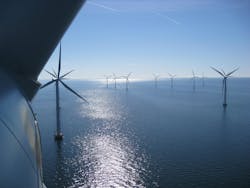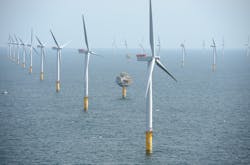Energy transition fueling offshore wind market growth
Gradual pivot toward low-carbon energy business models
Peter Brun, DNV GL
The oil and gas industry’s drive to decarbonize has stepped up a gear, according to global research from DNV GL. In its latest industry outlook report entitled, New Directions, Complex Choices, nearly three-quarters (71%) of senior oil and gas professionals expect their business to increase or maintain investment in renewable energy projects/portfolios in 2020, up from just over half (54%) on last year’s survey.
While the threat of climate change and the need to meet internationally agreed emissions targets has prompted governments to take major steps toward a lower carbon future, there is still a long way to go. It is encouraging to see that more than one-third of the 1,031 people surveyed (34%) believe the energy transition is stimulating spending intentions in clean energy. This suggests a gradual pivot toward low-carbon energy business models, likely to offset expected demand in the 21st century and mitigate carbon risk associated with fossil fuel energy sources.
In terms of scale and size, offshore wind is the most popular investment option, growing from 40% in 2019 to 63% in the year ahead. In another DNV GL report, Offshore wind: The power to progress, the technical advisor predicts that offshore wind’s contribution to global electricity creation will reach about 30% of total wind production by mid-century.
European continental shift and drift
In terms of raw resource availability and suitability, Europe has strong offshore wind potential coupled with the social and political will to push wind energy forward. In 2019, the UK and France joined the small but expanding list of countries to pass new-zero emissions targets into law.
Seventy-one percent of European respondents are most likely to raise or retain spending on offshore wind, according to the tenth annual industry outlook report. Notably, a similar proportion of those with upstream operations (73%) are expected to loosen the purse strings in this flourishing arena. With capabilities that suit the specific demands of offshore wind projects, Equinor, for example, will operate the 3.6-GW Dogger Bank wind farm, which is said will boast the world’s largest turbines (260 m/853 ft) – nearly three times the size of the Statue of Liberty – off the UK coastline.
In recent years, offshore wind’s levelized cost of energy (LCoE) has fallen significantly, particularly within Europe. In September 2019, the UK government revealed that mega projects achieved a new UK record low dropping 30% in two years with a raft of 12 new energy projects coming in at a record low price of between £39.65 and £41.61 ($51.62 and $54.18) per MWh.
As the industry strives to keep costs low, European developers are branching beyond the continent’s borders to emerging, and potentially, enormous markets in the Far East and Asia.
Operating projects in promising markets include the 252-MW Liuheng (Guodian Zhoushan Putuo) offshore wind farm in China. Taiwan, with its open market outlook on the international supply chain, is being very closely courted, while the potential of floating offshore wind technology in Japan, France, and the US West Coast is both huge and crucial for growth.
The company’s offshore wind report surmises varying reasons why European industry actors are looking to break into and bolster new markets:
• Driven by the latest significant LCoE reductions for new offshore wind generators – makes this green energy technology both very cost and consumer attractive
• The many (unexploited) attractive wind and site conditions in new regions are a logical investment asset for experienced players looking for new investment opportunities as competition in mature European markets has increased significantly in recent years
• The high growth in economies and demand for new power generation in some markets and decommissioning investment away from fossil fuel generators in other markets, makes new offshore wind investments very attractive.
US offshore wind
Though the US alone has an offshore wind power potential of 2,000 GW, double the nation’s current electricity use, just 30 MW has so far been installed.
However, the connection and interaction with the European supply chain has seen a few individual states, such as Massachusetts, New York, and New Jersey, stimulate a huge push toward offshore wind. For example, in 2019, Shell won its largest wind project to date, the 804-MW Mayflower Wind Energy project off Massachusetts (a joint venture of Shell New Energies US and EDPR Offshore North America).
The downward trend in offshore wind costs, aligned with the phase out of federal investment tax credits, has undoubtedly contributed to recent decisions by several states to procure offshore wind – there are $70 billion worth of investments projected in the next decade. Over the next 12 months however, the investment intentions of North American oil and gas professionals in offshore wind is notably less than their European counterparts (51% versus 62%).
As a comparatively young sector in the US, the bureaucratic process is cumbersome. The gatekeeper of outer continental shelf developments and activity, the Bureau of Ocean Energy Management (BOEM), identifies and leases wind energy areas, approves construction and operations plans, and ultimately gives final approval for the design and installation of each offshore wind farm. Some projects are facing approval delays causing heighted concern for global supply stakeholders, already contending with lack of infrastructure.
Though the ambition to shake-up the energy mix in the US is gaining momentum, the absence of a national comprehensive energy policy means there is tension between the speed at which the states want to move and the drawn-out federal government processes. Such determination will eventually prove the tipping point to allow offshore wind to prosper and play a credible role in a cleaner energy future in the US.
Energy transition on track
To meet energy demand, oil and gas will remain vital for decades. By 2050, it will account for 46% of the world’s energy mix, compared with 54% today, according to the technical advisor’s 2019 Energy Transition Outlook report.
The demand to decarbonize the oil and gas sector is clear as more than half of respondents globally (51%) wish their organization would move faster to develop and adopt lower carbon operations and practices. Barriers, such as risk profile, low financial return/profitability, and skills must be overcome to competently and safely see the shift from fossil fuels to a variety of energy sources to meet net zero targets. Sixty percent believe their organization is actively adapting to a less carbon-intensive energy mix – up from 44% two years ago.
The global oil and gas industry is well placed to fund and foster the development of offshore wind projects now and in the future.
The sector’s expertise, capabilities, and inherent attitude to innovate will see more support for large offshore wind construction and maintenance programs. Likewise, safety leadership will underpin the social license to operate and give the sector a competitive advantage as it delves deeper into renewables. •

